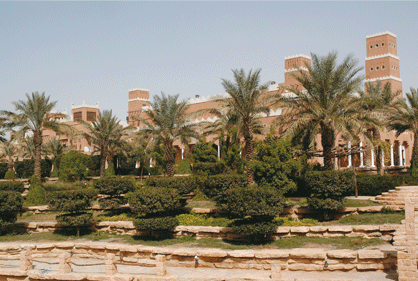
 AlDere’ayah
AlDere’ayah
Birthplace of the
If any single location in
Photos: Hisham Shamma
Ibn Saud and his immediate descendants brought the whole Najd region together with the eastern and western regions of
Silent and gently decaying atop the steep banks of Wadi Hanifa, which divides the old city of Direayah in two, the now partially restored settlement was once home to the Al-Saud family and Muhammad ibn Abdul Wahhab, the two seminal forces at the foundation of modern Saudi Arabia.
Much of the old city of
However, armed with some slight understanding of the history of the site the restored buildings, walls and even the geographical position of the city overlooking the life-giving waters of Wadi Hanifa that sustained the population, the visitor is able to relate to Saudi Arabia’s history and feel a sense of continuity in a way not offered by any other site in the Kingdom’s achieves. What is now
 As with any city, the settlement is made up of discrete quarters forming a cohesive whole. The Turaif Quarter, on the southwestern side of the hill that supports the city and is surrounded by a fortified wall, is the largest quarter and is where the Al Saud Palace stands. The Ghusaiba Quarter is smaller but has the distinction of being the first capital — up to 1683. The Bujairy Quarter, which lies on the eastern bank of Wadi Hanifa, is the location for the mosque, school and home of Muhammad ibn Abdul Wahhab.
As with any city, the settlement is made up of discrete quarters forming a cohesive whole. The Turaif Quarter, on the southwestern side of the hill that supports the city and is surrounded by a fortified wall, is the largest quarter and is where the Al Saud Palace stands. The Ghusaiba Quarter is smaller but has the distinction of being the first capital — up to 1683. The Bujairy Quarter, which lies on the eastern bank of Wadi Hanifa, is the location for the mosque, school and home of Muhammad ibn Abdul Wahhab.
The history of Direayah proper dates back to the 15th century. According to historians of the
Initially, Mani and his clan — the Mrudah — settled in Ghusaybah and Al-Mulaybeed. The entire settlement was named Al-Direayah after Mani’s benefactor Ibn Dir. Later settlers moved into the district of Turaif and families from other towns or from the bedouin tribes of the near desert settled in the area and by the 18th century Direayah had become a well-known town in
Aspirations to power caused shifts and realignments in the social structure of the community and eventually Muhammad ibn Saud emerged from a struggle within the ruling family of Al-Direayah, the Al-Miqrin — sons of Miqrin who was a descendant of Mani, and became the emir of Direayah.
In 1744, Ibn Saud hosted the famous religious scholar Muhammad ibn Abdul Wahhab, who came from the town of Al-Uyaynah, located on the same wadi about 45 km upstream. Ibn Saud agreed to implement Ibn Abdul Wahhab’s religious views and with them and his already established authority laid the foundations of what later became known as the
Over the next few decades, Ibn Saud and his immediate descendants brought the whole Najd region together with the eastern and western regions of
The major power of the time was the
Ibrahim Pasha, the leader of the invading force, ordered the sacking of the capital. When a member of the local nobility tried to revive the Wahhabi state in Direayah, Ibrahim ordered his troops to destroy the town and set the remains on fire. When the Saudis revived their fortunes in 1824 and again in 1902, they moved their capital further south in
Some of the buildings have been restored both internally and externally. Traditional techniques have been used throughout with very little substitution of modern materials for the traditional mud and straw adobe bricks and facade of the original buildings. The surface texture of the walls is given by the straw reinforcement mixed into the exterior covering and mud bricks, made only a few years ago are almost indistinguishable from the original where they are visible.
Purists say that the restored buildings are probably better and cleaner that the originals ever were and carp at the inclusion of resin waterproofing in the plasterwork. Valid points both — however, even if you knew either to be the case, this does not lessen the visual and physical impact of the restored sites. The materials at least are very nearly the same as the original and are not painted concrete as in many “Historical Villages” dotted about the Gulf region. The restoration so far addresses the balance of “original” contra “durability” in a sensitive and imaginative way.
The
The Guest House and At-Turaif Bath House is a building that rambles around a number of small courtyards onto which rooms open to take in the air. The Bath House is famous for its different architectural styles and shows the ingenuity of the craftsmen in those days. The building was waterproofed by using different mixes of plaster depending on what the structure was designed to do. Both the Guest and Bath Houses were supplied with water from a well in the wadi below.
Given that Islam is at the center of daily life and governance of
The relatively small area of the ruins of Direayah, the close proximity of the center of governance of the first
As if placed to remind the visitor of the continuity of the relatively short timeline that is modern Saudi history, the stark glass cliff of the